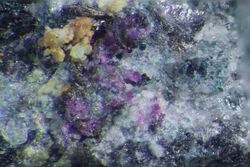Chemistry:Putnisite
| Putnisite | |
|---|---|
 Putnisite, from Polar Bear Peninsula, Western Australia, Australia | |
| General | |
| Category | Mineral |
| Formula (repeating unit) | SrCa4Cr83+(CO3)8(SO4)(OH)16·25 H2O |
| Crystal system | Orthorhombic |
| Crystal class | Dipyramidal (mmm) H-M symbol: (2/m 2/m 2/m) |
| Space group | Pnma |
| Unit cell | a = 15.351 Å, b = 20.421 Å, c = 18.270 Å; Z = 4 |
| Identification | |
| Color | Purple |
| Crystal habit | Pseudocubic crystals |
| Cleavage | [100], [010] and [001] good |
| Fracture | Brittle – uneven |
| Mohs scale hardness | 1.5–2 |
| |re|er}} | Vitreous |
| Streak | Pink |
| Diaphaneity | Translucent |
| Specific gravity | 2.20 |
| Optical properties | Biaxial (−) |
| Refractive index | nα = 1.552, nβ = 1.583 and nγ = 1.599 |
| Pleochroism | Distinct: X pale bluish grey, Y pale purple, Z pale purple |
| References | [1][2][3][4] |
Putnisite is a mineral composed of strontium, calcium, chromium, sulfur, carbon, oxygen and hydrogen.[3] It was discovered on the Polar Bear Peninsula in Shire of Dundas, Western Australia in 2007 during mining activity.[3][4] Following identification and recognition by the IMA in 2012[4] the mineral was named after mineralogists Andrew and Christine Putnis.[2]
Putnisite has unique chemical and structural properties, and does not appear to be related to any of the existing mineralogical families.[2] Crystals are translucent purple, but show distinct pleochroism (from pale purple to pale bluish grey,[3] depending on the angle of observation) and leave pink streaks when rubbed on a flat surface.[3]
Putnisite occurs as small (< 0.5 mm) cube-like crystals in volcanic rock.[2] The mineral formed during the oxidation environment within komatiite to dioritic bodies containing sulfide minerals.[3]
References
- ↑ Mineralienatlas
- ↑ 2.0 2.1 2.2 2.3 "New Mineral Shows Nature's Infinite Variability". University of Adelaide. http://www.adelaide.edu.au/news/news70062.html. Retrieved 26 April 2014.
- ↑ 3.0 3.1 3.2 3.3 3.4 3.5 Elliott, P. (February 2014). "Putnisite". Mineralogical Magazine 78 (1): 131–144. doi:10.1180/minmag.2014.078.1.10. http://minmag.geoscienceworld.org/content/78/1/131.abstract. Retrieved 26 April 2014.
- ↑ 4.0 4.1 4.2 "Putnisite: Putnisite mineral information and data". Mindat.org. 2014-04-07. http://www.mindat.org/min-42732.html. Retrieved 2014-04-29.
- ↑ Warr, L.N. (2021). "IMA–CNMNC approved mineral symbols". Mineralogical Magazine 85 (3): 291–320. doi:10.1180/mgm.2021.43. Bibcode: 2021MinM...85..291W. https://www.cambridge.org/core/journals/mineralogical-magazine/article/imacnmnc-approved-mineral-symbols/62311F45ED37831D78603C6E6B25EE0A.
 |

